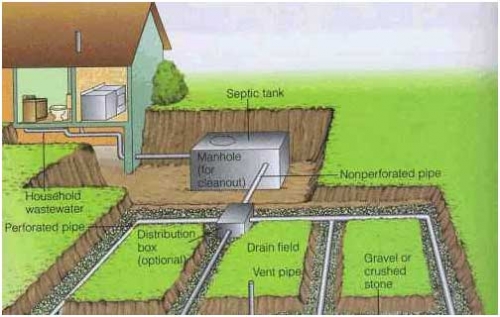Managing waste: Household septic systems - Part 1
Understanding how a household wastewater treatment system works can help protect an individual’s health and the environment.
Where does your household waste water go when it goes down the drain from your sink or toilet? There are two options: It goes to a municipal waste water treatment facility where it is cleaned and returned to the environment, or it is collected and cleaned on the property through a septic system before going back into the environment. According to the Department of Environmental Quality, there are 1.4 million household septic systems in use throughout Michigan. This accounts for more than 30% of all Michigan households.
 The best way to protect your health and the environment is to understand how a septic system works, what is proper use and maintenance and what are the signs to indicate a problem with a septic system.
The best way to protect your health and the environment is to understand how a septic system works, what is proper use and maintenance and what are the signs to indicate a problem with a septic system.
A septic system has two parts: a septic tank and an absorption or drain field. The septic tank is a watertight box or cylinder usually made out of concrete or plastic. Most tanks are double-chambered tanks meaning the tank is divided into two sides. A double-chamber tank is recommended because it provides better retention of sludge which protects the drain field. The drain field is connected to the tank by a pipe. The field is usually perforated plastic pipe laid in gravel-filled trenches just below the surface of the ground.
Wastewater flows out of the sewer pipe from the house into the septic tank. Lighter solids, such as grease, soap scum and hair, float to the top of the tank. This is called the scum layer. Heavier solids drop to the bottom of the tank. A baffle or T-pipe is located approximately two-thirds up from the bottom of the tank. This baffle allows the liquids to leave the tank while keeping the solids in the tank until they can be pumped during regular maintenance.
The liquid waste, called effluent, enters the absorption field using gravity to feed the effluent evenly through the rows of pipes. This waste slowly percolates through the gravel base into the soil below where additional particles and pathogens are filtered out by the soil.
The septic tank and drain field should have adequate capacity to hold two day’s worth of waste water even during peak use. The two day recommendation is usually long enough to allow solids to settle to the bottom of the tank. Use the box below to determine how large your septic tank should be.
|
Determining Septic System Capacity The average person uses about 75 gallons of water per day. Most sizing guidelines utilize 150 gallons per bedroom to determine the size of a septic tank. Use the following equation to estimate the minimum tank capacity needed to handle your household’s waste water. Your septic tank should be large enough to hold two day’s worth of wastewater. ____Number of bedrooms in household x 150 gallons per day = _____ x 2 days = ____gallons of waste water generated in 2 days from the home ____Septic tank capacity (gallons) Contact County Health Department if you do not have records Which is greater: _____ 2-day amount OR ____ Septic tank capacity (Check one) IF your 2-day waste water amount is larger than your septic tank capacity, you need to reduce your waste water amount or upgrade your system. Information courtesy of Macomb County Health Department & Home*A*Syst bulletin WQ51 |
There are several factors that determine the size and design of the absorption (drain) field. The size is determined by the amount of waste water going into the system and how much water the soil can absorb. Loam-type soils are best because they are medium-textured and drain well. Gravely or sandy -type soils allow the waste water to run through the soil too fast for treatment. Clay or compacted soils hold the water too long before it is absorbed which may cause the system to go anaerobic (without oxygen) leading to foul odors and possible system failure.
Related MSU Extension News articles:



 Print
Print Email
Email

